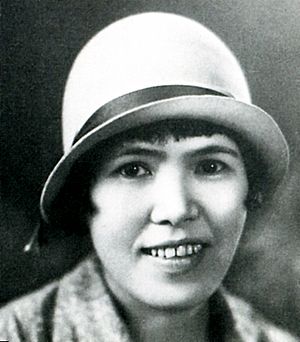Nobuko Yoshiya facts for kids
Quick facts for kids
Nobuko Yoshiya
|
|
|---|---|

Nobuko Yoshiya
|
|
| Born | 12 January 1896 Niigata, Japan |
| Died | 11 July 1973 (aged 77) Kamakura, Japan |
| Occupation | Novelist |
Nobuko Yoshiya (吉屋 信子, Yoshiya Nobuko, 12 January 1896 – 11 July 1973) was a famous Japanese novelist. She wrote many popular books during the Taishō period and Shōwa period in Japan. She was known for her romantic novels and stories for teenage girls. Nobuko Yoshiya was also a pioneer in writing about special friendships between girls. Many of her stories were even made into movies!
Contents
About Nobuko Yoshiya's Life
Nobuko Yoshiya was born in Niigata Prefecture, Japan. She grew up in Mooka and Tochigi cities. Her family moved often because her father was a government official. She was the youngest of five children and the only daughter. Her parents came from samurai families. They wanted her to learn traditional skills for women in Meiji Japan.
Nobuko loved writing from a young age. This meant she spent less time on domestic skills. In 1915, she moved to Tokyo. There, she started to live differently from what was expected of women at the time.
Breaking the Rules
Nobuko Yoshiya often dressed in a unique style. She sometimes wore clothes that were not typically for women. She was one of the first Japanese women to cut her hair short in the 1920s, like Western fashion.
She also broke other rules. Nobuko was one of the first Japanese women to own a car. She even designed her own house! She was also the first Japanese woman to own a racehorse. Horse racing and golf became her favorite hobbies.
Life in Kamakura
Nobuko Yoshiya lived in Kamakura during and after World War II. In 1962, she built a beautiful traditional Japanese house with a garden. When she passed away, she gave her house to the city of Kamakura. She wanted it to be used to help women with cultural and educational activities.
She died at age 77 from colon cancer. Her house is now the Yoshiya Nobuko Memorial Museum. It shows her study just as she left it, with her handwritten notes and favorite items. The museum is open only a few days a year in May and November. Her grave is at the Kōtoku-in temple in Kamakura, near the famous Great Buddha statue.
Her Lifelong Companion
In 1923, Nobuko Yoshiya met Monma Chiyo. Monma was a mathematics teacher. They shared a special bond for over 50 years. Nobuko was open about her personal life. She shared details through photos and interviews.
In 1926, they began working together. Monma Chiyo became Nobuko's secretary. In 1957, Nobuko officially adopted Monma as her daughter. This was the only legal way for them to share property and make important decisions for each other back then. They traveled the world together. They visited places like Manchuria, the Soviet Union, and Paris. They also explored the Dutch East Indies and French Indochina.
Nobuko Yoshiya's Writing Career
One of her first popular works was Hana monogatari (meaning "Flower Tales"). This was a series of 52 stories written between 1916 and 1924. These tales were about close friendships between girls. They became very popular with female students. The stories often showed deep feelings and special connections.
Her book Yaneura no nishojo ("Two Virgins in the Attic", 1919) is thought to be partly about her own life. It describes a special bond between two girls living in a dorm. In the story, the girls decide to live together. This book showed a strong belief in women's independence. It also hinted at Nobuko's own deep friendships.
In 1920, her book Chi no hate made ("To the Ends of the Earth") won a literary prize. It showed some Christian influences.
In 1925, Nobuko started her own magazine called Kuroshoubi (Black Rose). She stopped it after eight months. After this, her stories began to show deep female friendships as a kind of 'sisterhood'. These stories became more widely accepted.
Famous Works
Nobuko Yoshiya wrote many other important books. These include:
- Onna no yujo ("Women's Friendship", 1933–1934)
- Otto no Teiso ("A Husband's Chastity", 1936–1937)
- Onibi ("Demon Fire", 1951)
- Atakake no hitobito ("The Ataka Family", 1964–1965)
- Tokugawa no fujintachi ("Tokugawa Women", 1966)
- Nyonin Heike ("Ladies of the Heike", 1971)
Her Unique Writing Style
Nobuko Yoshiya's stories about deep female friendships greatly influenced later shōjo manga (Japanese comics for girls). She helped develop a special Japanese genre called Class S. This genre focused on intense, platonic friendships between girls.
She helped make the idea of "romantic friendship" important in Japanese culture. Her stories often showed very close female friendships as a pure, platonic love. These bonds were often seen as part of youth. They helped girls socialize and build strong connections. Her writing style was often dramatic and full of romantic descriptions. It showed deep friendships as important and strong relationships.
Nobuko Yoshiya lived openly with her female companion. Because of this, many of her early works are seen as being about her own experiences. They often showed unrequited love or longing from afar. These stories subtly showed her personal experiences with deep female friendships.
Later, her stories focused more on platonic friendships. They idealized the bond between innocent girls. During this time, she became very famous for her youth women's literature. Her works were seen as wholesome because of the platonic nature of the relationships. Girls and young women loved her ideas of eternal friendship and idealized sisterhood. They also liked her realistic portrayal of women's lives.
Nobuko Yoshiya's Views
Nobuko Yoshiya was a strong supporter of women's rights. However, she did not trust political parties. She never joined the organized women's rights movement in Japan.
See also
 In Spanish: Nobuko Yoshiya para niños
In Spanish: Nobuko Yoshiya para niños
- Japanese literature
- List of Japanese authors

